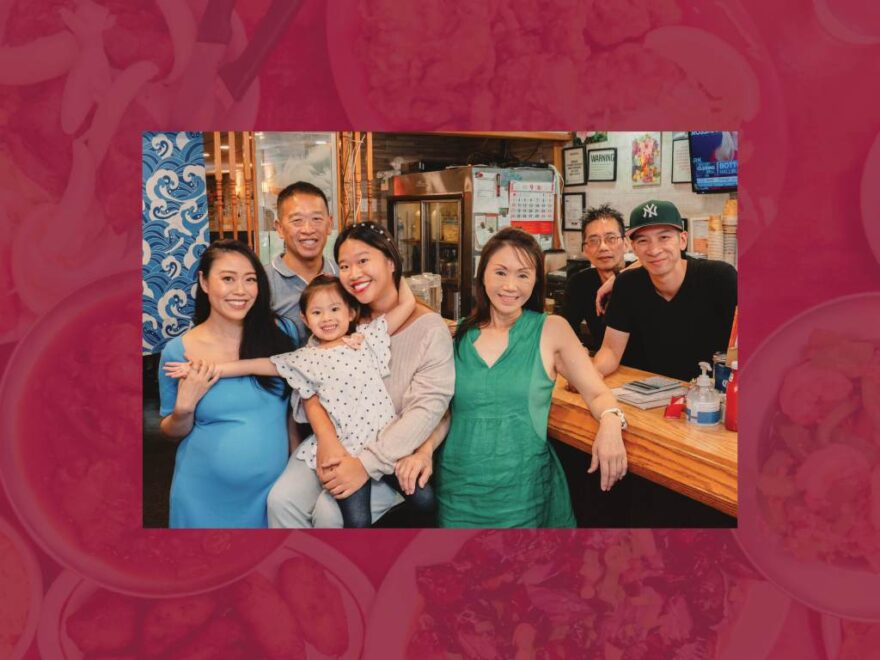“What are you eating?”
I still remember the day in high school when food suddenly made me question my heritage. I was eating ropa vieja and bok choy with white rice — a totally normal meal in my Chino Latino household. But the kids around me gave my food curious looks and then turned their gaze back to me, their questions unspoken. To me, it was just lunch. To them, it was proof that I was different.
Growing up, my understanding of cultural heritage was not like most kids. While many of my friends could easily trace their roots to a specific country or culture, my family’s heritage was a delightful blend of three seemingly distinct worlds: Chinese, Latino, and American.
From a young age, I knew my mom’s family had immigrated from China to Uruguay, and while I struggled with the pronunciation of the country, our shared love of telenovelas hinted at our connection to Latin culture. Still, it was challenging for me to identify my mom as Uruguayan since she resembled me and sounded similar. This disconnect deepened because I couldn’t speak Spanish fluently like she did. (My parents believed I didn’t have a strong passion or interest in the language, so they didn’t actively teach me.) Nevertheless, my mom always made sure to remind my siblings and me of her roots.
My Chinese heritage has been deeply ingrained in me, too. My dad’s family immigrated from China and Hong Kong to New York City in the late 1950s, and I’ve always felt Chinese American. For the first decade of my life, I attended a bilingual school in Manhattan, immersing myself in studies from 8:30 AM to 5:30 PM daily, the last two and a half hours dedicated solely to Mandarin.
Surrounded by peers who shared my appearance and upbringing only strengthened that connection; I celebrated two New Years, eagerly receiving red envelopes during the Lunar New Year. Our Chinese traditions also included an annual ‘Bai-San’ day, where we paid homage to our ancestors by visiting the cemetery and offering food. One cherished delicacy during this time was ‘Bak Ting Gao’ (steamed rice cake), a once-a-year treat that my cousin and I eagerly anticipated.
Following Bai-San, our family gathered in bustling Chinatown restaurants, savoring dishes from succulent roasted duck to oysters drizzled in hoisin sauce. Whether for birthdays, weddings, or milestone achievements, the significance of food in binding our family and culture together cannot be understated. Food has always been our shared connection.
But my transition from a bilingual elementary school in Manhattan, where I had spent years surrounded by kids who looked like me, to a Staten Island high school marked a stark change. This shift was the first time I truly felt ‘othered.’ What are you eating?
Still, it didn’t bother me so much when I could come home to a steamed plate of beef and broccoli with noodles or fried rice with Milanesa de Pollo (Chicken Milanese). My worries about not fitting in with my peers melted away as soon as I got a whiff of whatever my mom was cooking in the kitchen. As a kid, she used food to express her love and connection to Uruguay. Home was where the unique fusion of my Chinese and Latin American heritages came to life in the most delicious way possible — through food.
The Best of Both Worlds
Another place they came through was my uncle Mike’s fusion restaurant, La Dinastia. As a child, I didn’t fully grasp the concept of Chino Latino cuisine. To me, it was simply a place where I could enjoy mouthwatering dishes that melded the flavors of my two worlds. For those unfamiliar with Chino Latino cuisine, it’s essentially Chinese food with a Latin American twist, inspired by the migration of Chinese workers to Latin/South America. This unique culinary fusion blends the best of both worlds, resulting in dishes that are nothing short of extraordinary.
Nestled in the heart of New York City’s Upper West Side neighborhood, La Dinastia has been a fixture in my life for as long as I can remember. My mom’s brother — my uncle Mike — has worked there for years and through his dedication became a part-owner. In any given conversation with my mom, you can catch them bouncing between the three languages they speak. It’s pretty cool.
La Dinastia has been a favorite among locals for over 30 years. It’s a menu where you can get chicken chop suey with tostones on the side, and no one thinks it’s a weird combination (as my high school classmates did).
One of the most unique aspects of La Dinastia is the blending of cultures and languages that occurs within its walls. Chinese workers, who immigrated to Latin America and mastered the Spanish language, serve a diverse clientele. I remember looking up from my homework and seeing Chinese workers effortlessly converse in Spanish with customers. It always felt natural to me, reflecting the beautiful fusion of cultures that my family cherishes.
Through this culinary journey, my family has managed to keep alive our Chino Latino heritage.
La Dinastia is not just a restaurant; it’s a living testament to the rich cultural tapestry that defines my family’s identity. With each bite of Chino Latino cuisine, we honor our roots, celebrate the diverse influences that have shaped our family, and continue to build bridges between two vibrant worlds.
What are you eating? In a world that often emphasizes our differences, it is the shared love for food and culture that unites us. For me, La Dinastia represents a warm and welcoming space where my Chino Latino heritage thrives, reminding me — and its many patrons — that our family’s unique blend of cultures is something to be celebrated and shared with the world, one delicious dish at a time.
Source: Read Full Article

